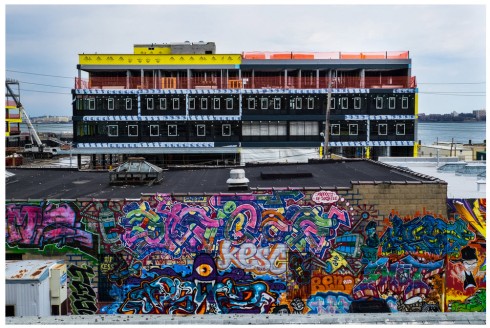
Manhattan’s proximity drives Hoboken, Jersey City, demand while some markets lag
By EVELYN LEE
The nascent housing rebound is playing out differently in New Jersey’s cities: While established urban residential real estate markets are seeing an uptick in occupancies and rental rates, more unproven markets will have a longer road to
recovery, experts said.

“New Jersey’s urban areas are very disparate areas,” said John McIlwain, senior fellow for housing at the Urban Land Institute, in Washington. While some cities are doing well, “there’s places like Trenton and Camden, which are challenged and have been for a long time.”
Among the strongest-performing urban housing markets are those located close to Manhattan. “We’re seeing a tremendous amount of resurgence in the urban housing markets along the Hudson River waterfront,” said Carl Goldberg, managing partner at Roseland Property Co., based in the Short Hills section of Millburn. Roseland recently opened the Monaco, a 524-unit residential tower in Jersey City, which rented more than 40 apartments in its first 15 days, and is now renting more than 20 apartments per week, Goldberg said. “That kind of absorption is almost unprecedented,” he said. Because residential construction dropped off sharply during the recession, demand now outweighs supply, he said.
“In general, the primary markets accelerate first, then they start pulling the properties a little bit further afield,” said David Barry, president of Ironstate Development Co., a Hoboken-based real estate developer.
“Certainly, in Hoboken, Jersey City, we’re already seeing strengthening,” Barry said. The rental recovery in those cities is already occurring, with occupancies in those cities running at 98 percent, compared to levels “in the low 90s” in 2009, he said. Concessions also have largely disappeared, he said.
The for-sale condominium market in those cities, however, will lag rentals, since greater job growth and rental rate appreciation will need to occur for condominium demand to increase, Barry said, predicting “a modest year, because there’s some inventory that needs to be absorbed.”
Urban housing demand is largely being driven by a younger demographic — people who are in their 20s and 30s and working in more entry-level jobs, Barry said. In many cases, they also grew up in a town in the general vicinity of that city, people who move to Hoboken or Jersey City, for example, often are from northern New Jersey. “People go to places they’re comfortable with,” he said.
Proximity to New York is a high driver of demand, but so is access to mass transit, Goldberg said- “If people move into urban communities, they want to greatly diminish the use of their car.”
While “places like Jersey City and Hoboken are coming back” because of their location advantage, a strong rebound in those areas isn’t likely until next year” McIlwain said. The housing market remains very weak nationally, though Manhattan is faring better than the rest of the country, he said.
“When prices start to rise again in Manhattan, that pushes people out,” he said. “People will be looking for more attractive and more affordable alternatives.”
As better-known residential markets like Hoboken and Jersey City begin to strengthen — and get more expensive — “people will start to look at less-established markets to get more space for less money,” Barry said.
According to Goldberg, secondary urban housing markets in New Jersey are priced at about 60 to 70 percent of what Hudson riverfront properties command.
One such market is Harrison, where Roseland and Millennium Homes built River Park at Harrison in 2008, and where Ironstate is currently constructing its first project in the town, the 280-apartment Harrison Station, with completion expected in September.
“Harrison is where Jersey City was 15 years ago,” said Barry, noting that in the mid-’90s, when Ironstate built its first project in the latter municipality— Portside at Paulus Hook — the new development was surrounded by industrial buildings. Today, Harrison Station is going up in the same predominantly industrial area as River Park, the only other major residential project to be built in the town in recent years, he said.
“I’m very confident Harrison has all the characteristics of an area that is going to be immensely successful,” he said. “It’s unbelievably connected to all these employment areas,” in Newark, Jersey City and Manhattan, that can be accessed in a 15-minute PATH ride. But if Ironstate’s project is considered a first step,
“Harrison needs to take six or eight or 10 more steps to get to where it needs to be,” he added. That’s “going to play out over the next 10 or 15 years.”
While Manhattan is seen as a strong driver of urban housing markets in northern New Jersey, it has less of an impact on New Jersey cities farther south. Long Branch, where Ironstate is building the master-planned community Pier Village, “is a slightly different equation, because there are subpockets of employment” in Middlesex and Monmouth counties, Barry said.
In New Brunswick, meanwhile, the residential market “has sustained itself over the last recession,” partly because of its more localized drivers of demand, said Christopher J. Paladino, president of New Brunswick Development Corp.
New Brunswick has “a bit of an artificial market” because of Rutgers University’s location in the city, he said. “The student housing market is not dramatically impacted by economic cycles.”
The city also didn’t see significant layoffs from the university and its other major employers. Johnson &Johnson and the Robert Wood Johnson University and St. Peter’s University hospitals- Still, the local housing market did weaken somewhat in the downturn: although occupancy rates have largely held steady, for-sale condominiums are now priced at about $150,000 below their peak, and rental rates also have declined, he said.
Devco is constructing 200 rental and for-sale units at its Gateway project, adjacent to the New Brunswick train station. “We’re looking to try to facilitate a longer-term living commitment to the city than your average renter,” Paladino said. The strategy is to price condos at levels that are attractive to a younger couple, where “she may be a young physician at the hospital, and he
may be an administrator at the university,” he said.
While cities like Newark may have a geographic advantage over New Brunswick in being closer to Manhattan, “we’ve had a 10-year headstart” on non-Gold Coast cities, building more than 1,000 new rental and for-sale units in the past eight years, Paladino said.
In does such as Newark, Elizabeth, Rahway, Trenton and Camden, “residential development is still in the pioneering stages.”
In Newark, “it’s going to take some years and hard work” for a recovery to take hold, McIlwain said. There’s a lot of issues it’s still working through.” And Camden as a whole “is still financially struggling and has a long way to go.”
Overall, growth in New Jersey’s urban areas has been occurring at a slower rate than it did in the 1990s, he said. “The future of urban areas in New Jersey is mixed,” McIlwain said. “There will continue to be empty nesters and young professionals moving into urban areas,” he said. “There will also continue to be families with kids moving out to the suburbs.” That will likely create a net loss in the state’s urban populations, since the new households living in the cities will be much smaller, and some urban housing markets could have more units built than people moving in, he said: “That will be a trend that will continue.”
See the full clip here: NJ Biz – New Jersey’s Cities are on the Rebound













